Global point of care
Dangerous side-effects.
Every year, 4,000 US drivers die with drugs in their system — and that staggering figure doesn’t even include all of the other people they kill in the process.1
From cocaine to prescription medication, drugs have a profound effect on the brain. Some compromise sound judgment and decision-making. Some trigger aggressive and reckless behavior. Others slow reflexes and decrease motor function.
For all these reasons, operating under the influence of drugs leads to accidents, injuries, and even fatalities. In 2005, prescription medications were found in 46.5% of US drugged drivers involved in fatal crashes and the percentage has increased steadily since.2
Nonetheless, many people remain unaware of the risks of getting behind the wheel with drugs in their system — even small amounts of certain drugs can have a big impact on their ability to drive.
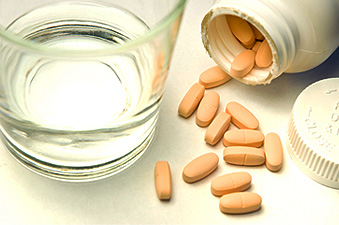
In US, more than 22% of drivers tested positive for illegal, prescription, or over-the-counter drugs.3
In Australia, 25% of all people killed in an auto accident had drugs in their bodies, according to research commissioned by the Road Safety Committee of the Parliament of Victoria.4
Driving with alcohol and/or drugs produced higher risk of serious of fatal injury – between 20 and 200 times that of sober drivers.5
Dangerous side-effects.
Every year, 4,000 US drivers die with drugs in their system — and that staggering figure doesn’t even include all of the other people they kill in the process.1
From cocaine to prescription medication, drugs have a profound effect on the brain. Some compromise sound judgment and decision-making. Some trigger aggressive and reckless behavior. Others slow reflexes and decrease motor function.
For all these reasons, operating under the influence of drugs leads to accidents, injuries, and even fatalities. In 2005, prescription medications were found in 46.5% of US drugged drivers involved in fatal crashes and the percentage has increased steadily since.2
Nonetheless, many people remain unaware of the risks of getting behind the wheel with drugs in their system — even small amounts of certain drugs can have a big impact on their ability to drive.

In US, more than 22% of drivers tested positive for illegal, prescription, or over-the-counter drugs.3
In Australia, 25% of all people killed in an auto accident had drugs in their bodies, according to research commissioned by the Road Safety Committee of the Parliament of Victoria.4
Driving with alcohol and/or drugs produced higher risk of serious of fatal injury – between 20 and 200 times that of sober drivers.5
Dangerous side-effects.
Every year, 4,000 US drivers die with drugs in their system — and that staggering figure doesn’t even include all of the other people they kill in the process.1
From cocaine to prescription medication, drugs have a profound effect on the brain. Some compromise sound judgment and decision-making. Some trigger aggressive and reckless behavior. Others slow reflexes and decrease motor function.
For all these reasons, operating under the influence of drugs leads to accidents, injuries, and even fatalities. In 2005, prescription medications were found in 46.5% of US drugged drivers involved in fatal crashes and the percentage has increased steadily since.2
Nonetheless, many people remain unaware of the risks of getting behind the wheel with drugs in their system — even small amounts of certain drugs can have a big impact on their ability to drive.

In US, more than 22% of drivers tested positive for illegal, prescription, or over-the-counter drugs.3
In Australia, 25% of all people killed in an auto accident had drugs in their bodies, according to research commissioned by the Road Safety Committee of the Parliament of Victoria.4
Driving with alcohol and/or drugs produced higher risk of serious of fatal injury – between 20 and 200 times that of sober drivers.5

Drugged driving kills or injures thousands of people every year. We could make it more difficult for people to drive under the influence of drugs with the tools that are currently available such as roadside oral fluid testing. We need to put lives and safety first and stop drugged driving.
— Candace Lightner, President of We Save Lives, and Founder of Mothers Against Drunk Driving (MADD)
In Australia, random drug testing is a proven deterrent. More than 41% of drug users surveyed choose not to drive, for fear of being caught.7
A SINGLE PROBLEM WITH MULTIPLE SOLUTIONS.
Even though many countries are increasing education programs and awareness campaigns, the problem of drugged driving only continues to grow.
As part of a multi-tiered approach to address the problem, tougher “zero-tolerance” laws are now spreading across western European nations, Australia, New Zealand and some US states. However, unlike the statutes for alcohol-impaired driving, drug-impaired driving laws are nuanced, inconsistent from one country to another, and are difficult to enforce and prosecute.
Another way to deter drugged driving is through roadside testing. Around the world, law enforcement officers are being trained to recognize the signs of substance-impaired driving through coordination tests, behavioral tests, speech impairment, and other methods.
In recent years, police have gained access to technology that can confirm drug use. Part of the solution is drug testing to aid police in testing for drugs in the driver’s system. Previously, accurate drug testing required sending urine or blood samples to a laboratory — which could delay results for days.
Now, testing can be done at the roadside.
A SINGLE PROBLEM WITH MULTIPLE SOLUTIONS.
In Australia, random drug testing is a proven deterrent. More than 41% of drug users surveyed choose not to drive, for fear of being caught.7
Even though many countries are increasing education programs and awareness campaigns, the problem of drugged driving only continues to grow.
As part of a multi-tiered approach to address the problem, tougher “zero-tolerance” laws are now spreading across western European nations, Australia, New Zealand and some US states. However, unlike the statutes for alcohol-impaired driving, drug-impaired driving laws are nuanced, inconsistent from one country to another, and are difficult to enforce and prosecute.
Another way to deter drugged driving is through roadside testing. Around the world, law enforcement officers are being trained to recognize the signs of substance-impaired driving through coordination tests, behavioral tests, speech impairment, and other methods.
In recent years, police have gained access to technology that can confirm drug use. Part of the solution is drug testing to aid police in testing for drugs in the driver’s system. Previously, accurate drug testing required sending urine or blood samples to a laboratory — which could delay results for days.
Now, testing can be done at the roadside.



Putting drugged drivers to the test
Roadside testing can help provide law enforcement agencies the tools they need to test suspicious drivers and quickly get them off the road. The SoToxa™ Mobile Test System provides the portable technology needed to usher in a new era of testing at the roadside.
In minutes, this portable oral fluid analyzer can detect up to 6 different drug assays, from cannabis to cocaine to prescription medications. With analysis printouts on location, the SoToxa™ Mobile Test System eliminates subjectivity and misinterpretation of test results.
A US National Roadside Survey concluded that, in drivers tested for drug use, oral fluid gave as good as — if not better information — than blood.8
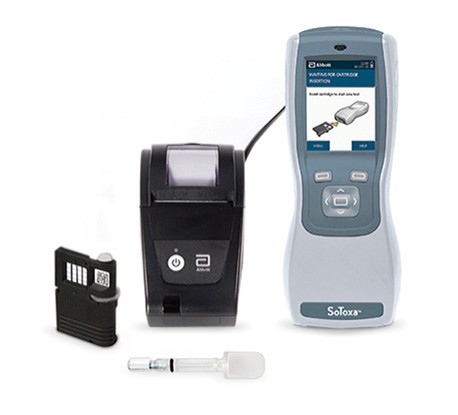
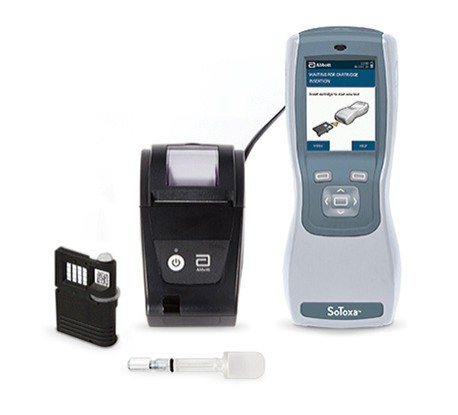

Portable and Easy to Use
The SoToxa™ Mobile Test System was designed to meet the high performance demands of law enforcement. The analyzer is portable, lightweight, easy to read, and compact to fit into any type of vehicle.
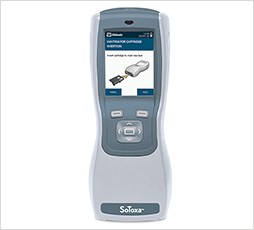
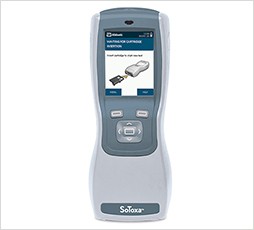

Simple Collection Process
Rapid oral fluid collections are easy to obtain while in the field — and less invasive than urine or blood sampling.
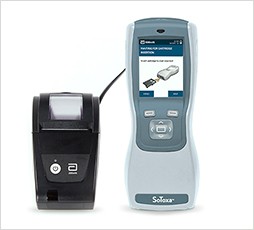
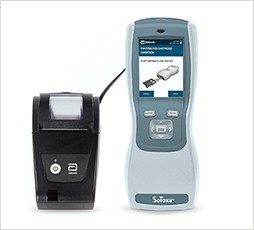

Manage Results
Avoid misinterpreting results. Featuring a full-color screen, the SoToxa™ Mobile Test System is easy to read anywhere. You can even print results right from the device.
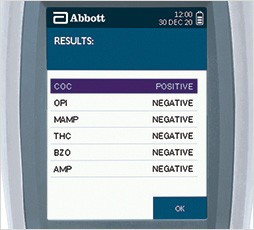
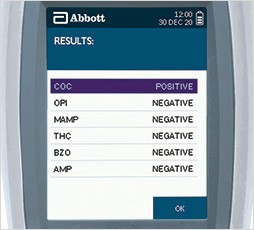

The potential to change lives is a driving force behind what we do.
Part of the solution
Keeping our roadways and families safe is our top priority. We designed and developed the SoToxa™ Mobile Test System to meet the high-performance demands of law enforcement, empowering police officers to take action and obtain immediate test results. Our portable handheld analyzer provides the optimal combination of speed, ease of use, reliability, and accuracy to get time-critical results when and where they are needed most.
View References
- Drug Involvement of Fatally Injured Drivers. Washington, DC: NHTSA National Center for Statistics and Analysis; 2010.
- Wilson FA, Stimpson JP, Pagán JA. Fatal crashes from drivers testing positive for drugs in the U.S., 1993-2010. Public Health Rep. 2014;129(4):342-350.
- Berning A, Compton R, Wochinger K. Results of the 2013–2014 National Roadside Survey of Alcohol and Drug Use by Drivers. Washington, DC: NHTSA National Center for Statistics and Analysis; 2015.
- Davis A, Quimby A, Odero W, Gururaj G, Hijar M. Improving Safety by Reducing Impaired Driving in Developing Countries: A Scoping Study. Crowthorne, UK: TRL Unpublished Project Report PR/INT/724/03.TRL; 2003.
- Hels T, Bernhoft IM, Lyckegaard A, et al. Risk of Injury by Driving With Alcohol and Other Drugs. DRUID—Driving Under the Influence of Drugs, Alcohol and Medicines, D2.3.5; 2011. http://www.druid-project.eu/Druid/EN/deliverales-list/downloads/Deliverable_2_3_5.pdf?__blob=publicationFile. Accessed March 25, 2016.
- Hughes B; European Monitoring Centre for Drugs and Drug Addiction (EMCDDA). Drugs in Focus: Responding to Drug Driving in Europe. Luxembourg: Office for Official Publications of the European Communities; 2009. http://www.emcdda.europa.eu/system/files/publications/539/TDAD09002ENC_177822.pdf. Accessed March 25, 2016.
- Mallick J, Johnston J, Goren N, Kennedy V. Drugs and driving in Australia: A survey of community attitudes, experience and understanding. Melbourne: Australian Drug Foundation; 2007. http://www.druginfo.adf.org.au/attachments/400_Drugs_and_Driving_in_Australia_fullreport.pdf. Accessed March 25, 2016.
- Lacey JH, Kelley-Baker T, Furr-Holden D, et al. 2007 National Roadside Survey of Alcohol and Drug Use by Drivers: Methodology. Washington, DC: US DOT/National Highway Traffic Safety Administration. www.nhtsa.gov/staticfiles/nti/pdf/811237.pdf. Accessed March 25, 2016.









